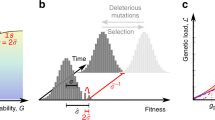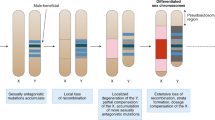Abstract
Discussions that are aimed at understanding the maintenance of sexual reproduction are in a bit of a quagmire owing to the many competing theories that have been proposed. Also, one of the central observations — that asexual lineages are typically short lived — still needs to be properly quantified. Exciting new results on ancient asexual organisms show that lineages can persist for many millions of generations without recombination. Understanding how they do so might well provide crucial new insights into the problem of sex.
This is a preview of subscription content, access via your institution
Access options
Subscribe to this journal
Receive 12 print issues and online access
$189.00 per year
only $15.75 per issue
Buy this article
- Purchase on Springer Link
- Instant access to full article PDF
Prices may be subject to local taxes which are calculated during checkout



Similar content being viewed by others
References
Kondrashov, A. S. Classification of hypotheses on the advantage of amphimixis. J. Hered. 84, 372–387 (1993).
Burt, A. Perspective: sex, recombination and the efficacy of selection — was Weismann right? Evolution 54, 337–351 (2000).
Agrawal, A. F. Sexual selection and the maintenance of sexual reproduction. Nature 411, 692–695 (2001).
Siller, S. Sexual selection and the maintenance of sex. Nature 411, 689–692 (2001).
Doncaster, C. P., Pound, G. E. & Cox, S. J. The ecological cost of sex. Nature 404, 281–285 (2000).
West, S. A. & Peters, A. D. Paying for sex is not easy. Nature 407, 962 (2000).
West, S. A., Lively, C. M. & Read, A. F. A pluralist approach to sex and recombination. J. Evol. Biol. 12, 1003–1012 (1998).
Brookfield, J. F. Y. Explanation and prediction and the maintenance of sexual reproduction. J. Evol. Biol. 12, 1017–1019 (1999).
Falush, D. Measuring the benefits of sex. J. Evol. Biol. 12, 1026–1028 (1999).
Gouyon, P.-H. Sex: a pluralist approach includes species selection (one step beyond and it's good). J. Evol. Biol. 12, 1029–1030 (1999).
Nunney, L. The maintenance of sex by group selection. Evolution 43, 245–257 (1989).
Rispe, C., Pierre, J.-S., Simon, J.-C. & Gouyon, P.-H. Models of sexual and asexual coexistence in aphids based on constraints. J. Evol. Biol. 11, 685–701 (1998).
Bell, G. The Masterpiece of Nature: the Evolution and Genetics of Sexuality (Croom Helm, London, 1982).
Barton, N. H. & Charlesworth, B. Why sex and recombination? Science 281, 1986–1990 (1998).
Kondrashov, A. S. Deleterious mutations and the evolution of sexual reproduction. Nature 336, 435–440 (1988).
Kondrashov, A. S. Sex and U. Trends Genet. 17, 75–77 (2001).
Keightley, P. D. & Eyre-Walker, A. Deleterious mutations and the evolution of sex. Science 290, 331–333 (2000).
Peters, A. D. & Keightley, P. D. A test for epistasis among induced mutations in Caenorhabditis elegans. Genetics 156, 1635–1647 (2000).
Hurst, L. D. & Peck, J. R. Recent advances in understanding of the evolution and maintenance of sex. Trends Ecol. Evol. 11, 46–52 (1996).
Horne, D. J. & Martens, K. Geographical parthenogenesis in European non-marine ostracods: post-glacial invasion or Holocene stability? Hydrobiologia 391, 1–7 (1998).
Peck, J. R., Yearsley, J. M. & Waxman, D. Explaining the geographical distributions of sexual and asexual populations. Nature 391, 889–892 (1998).
Grimanelli, D., Leblanc, O., Perotti, E. & Grossniklaus, U. Developmental genetics of gametophytic apomixis. Trends Genet. 17, 597–604 (2001).
Avise, J. C., Quattro, J. M. & Vrijenhoek, R. C. Molecular clones within organismal clones: mitochondrial DNA phylogenies and the evolutionary histories of unisexual vertebrates. Evol. Biol. 26, 225–246 (1992).
Butlin, R. K., Schön, I. & Martens, K. Origin, age and diversity of clones. J. Evol. Biol. 12, 1020–1022 (1999).
Maynard Smith, J. Age and the unisexual lineage. Nature 256, 661–662 (1992).
Martens, K. (ed.) Sex and Parthenogenesis: Evolutionary Ecology of Reproductive Modes in Non-Marine Ostracods (Backhuys Publ., Amsterdam, 1998).
Schön, I. et al. Long-term persistence of asexuality through mixed reproduction in Eucypris virens (Crustacea, Ostracoda). Heredity 84, 161–169 (2000).
Butlin, R. K., Schön, I. & Martens, K. Asexual reproduction in non-marine ostracods. Heredity 81, 473–480 (1998).
Judson, O. P. & Normark, B. B. Ancient asexuals. Trends Ecol. Evol. 11, 41–46 (1996).
Mark Welch, D. & Meselson, M. Evidence for the evolution of bdelloid rotifers without sexual reproduction or genetic exchange. Science 288, 1211–1215 (2000).
Rossetti, G. & Martens, K. Taxonomic revision of the Recent and Holocene representatives of the family Darwinulidae (Crustacea, Ostracoda), with a description of three new genera. Bull. K. Belg. Inst. Natuurw. Biologie 68, 55–110 (1998).
Judson, O. P. & Normark, B. B. Sinless originals. Science 288, 1185–1186 (2000).
Butlin, R. K. Virgin rotifers. Trends Ecol. Evol. 15, 389–390 (2000).
Wright, S. & Finnegan, D. Genome evolution: sex and the transposable element. Curr. Biol. 11, R296–R299 (2001).
Hickey, D. A. Selfish DNA — a sexually-transmitted nuclear parasite. Genetics 101, 519–531 (1982).
Arkhipova, I. & Meselson, M. Transposable elements in sexual and ancient asexual taxa. Proc. Natl Acad. Sci. USA 98, 14473–14477 (2000).
Schon, I. & Martens, K. Transposable elements and asexual reproduction. Trends Ecol. Evol. 15, 287–288 (2000).
Mark Welch, D. & Meselson, M. Rates of nucleotide substitution in sexual and anciently asexual rotifers. Proc. Natl Acad. Sci. USA 98, 6720–6724 (2001).
Schön, I., Butlin, R. K., Griffiths, H. I. & Martens, K. Slow molecular evolution in an ancient asexual ostracod. Proc. R. Soc. Lond. B 265, 235–242 (1998).
Schön, I. & Martens, K. Opinion: DNA repair in ancient asexuals — a new solution for an old problem? J. Nat. Hist. 32, 943–948 (1998).
Birky, C. W. Jr. Heterozygosity, heteromorphy, and phylogenetic trees in asexual eukaryotes. Genetics 144, 427–437 (1996).
Okubo, I. Freshwater ostracod Darwinula stevensoni from Lake Biwa. Bull. Biogeogr. Soc. Jpn 56, 39-43 (2001).
Acknowledgements
I am very grateful to D. Mark Welch, K. Martens, I. Schön, S. West and an anonymous referee for their insightful comments on earlier drafts of this article.
Author information
Authors and Affiliations
Related links
Glossary
- ALLOTETRAPLOID
-
A polyploid of hybrid origin in which there are four copies of each homologous chromosome per cell, two derived from each parent species.
- ANISOGAMOUS
-
A form of reproduction in which the male gametes are a different size to the female gametes.
- APOMIXIS
-
Reproduction that is exclusively through mitotic cell division, with no form of meiosis.
- BOOTSTRAP ANALYSIS
-
A type of statistical analysis to test the reliability of certain branches in the evolutionary tree. The bootstrap proceeds by re-sampling the original data, with replacement, to create a series of bootstrap samples of the same size as the original data. The bootstrap value of a node is the percentage of times that a node is present in the set of trees that is constructed from the new data sets.
- CLADE SELECTION
-
A clade is a lineage of organisms/alleles comprising an ancestor and its descendants. Clade selection is a form of group selection arising when a trait alters the probability of extinction of lineages that carry it, or the rate of production of new lineages, relative to those lineages that do not have the trait.
- FOURFOLD DEGENERATE SITE
-
The position in a coding region of DNA sequence at which the presence of any of the four bases is translated into the same amino acid.
- GENE CONVERSION
-
The non-reciprocal transfer of genetic information between homologous genes, as a consequence of mismatch repair after heteroduplex formation.
- MOLECULAR CLOCK
-
The principle that any gene or protein has a near-constant rate of evolution in all branches of a clade, which means that the amount of sequence divergence between two sequences will be proportional to the amount of time elapsed since their shared ancestor existed.
- MONOGONONT
-
A member of the rotifer class Monogononta, the sister clade to the Bdelloidea. They are cyclical parthenogens.
- MULLER'S RATCHET
-
The irreversible accumulation of deleterious mutations in asexual populations of finite size. The average load of mutations increases over generations because the class of individuals that carry the smallest number of mutant alleles is occasionally lost by genetic drift. In the absence of recombination, this class can never be re-created.
- NEGATIVE EPISTASIS
-
The increase in the harmful effect of a mutation when other deleterious mutations are simultaneously present in a genome.
- PARSIMONY
-
The principle that, as trait changes during evolution are rare, the hypothesis that minimizes the number of events that are required to explain the current distribution of a trait should be preferred.
- PARTHENOGENESIS
-
The production of offspring by a female with no genetic contribution from a male.
- RELATIVE-RATE TEST
-
A method for testing for constancy of base substitution rate in part of an evolutionary tree. If species A and B are sister taxa and C is an outgroup, then the number of substitutions that separate the pairs AC and BC are expected to be equal.
- VARIANCE
-
A measure of the variation around the central class of a distribution (the average squared deviation of the observations from their mean value).
Rights and permissions
About this article
Cite this article
Butlin, R. The costs and benefits of sex: new insights from old asexual lineages. Nat Rev Genet 3, 311–317 (2002). https://doi.org/10.1038/nrg749
Issue Date:
DOI: https://doi.org/10.1038/nrg749
This article is cited by
-
Genetic diversity and population structure of the invasive populations of goldfish Carassius auratus complex in Tibet
Biological Invasions (2023)
-
The origination events of gametic sexual reproduction and anisogamy
Journal of Ethology (2022)
-
Comparative genome anatomy reveals evolutionary insights into a unique amphitriploid fish
Nature Ecology & Evolution (2022)
-
Oxygen, life forms, and the evolution of sexes in multicellular eukaryotes
Heredity (2020)
-
Colony fitness and garden growth in the asexual fungus-growing ant Mycocepurus smithii (Attini, Formicidae)
Insectes Sociaux (2020)



